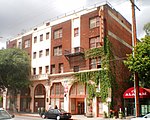Wrigley Field (Los Angeles)
1925 establishments in California1965 disestablishments in CaliforniaAmerican football venues in Los AngelesBaseball venues in Los AngelesBoxing venues in Los Angeles ... and 18 more
Defunct Major League Baseball venuesDefunct baseball venues in the United StatesDefunct college football venuesDefunct minor league baseball venuesDemolished buildings and structures in Los AngelesDemolished sports venues in CaliforniaHistory of Los AngelesLos Angeles Angels (PCL) stadiumsLos Angeles Angels stadiumsLoyola Lions footballNational Football League venues in Los AngelesPepperdine Waves footballSoccer venues in Los AngelesSouth Los AngelesSports venues completed in 1925Sports venues demolished in 1969Towers in CaliforniaWrigley Company
Wrigley Field was a ballpark in Los Angeles, California. It hosted minor league baseball teams in the region for more than 30 years. It was the home park for the minor league Los Angeles Angels during their run in the Pacific Coast League, as well as for the inaugural season of the major league team of the same name in 1961. The park was designed by Zachary Taylor Davis, who had previously designed both Chicago ballparks: Comiskey Park and Wrigley Field. The ballpark was also used as the backdrop for several Hollywood films about baseball, as well as the 1960 TV series Home Run Derby.
Excerpt from the Wikipedia article Wrigley Field (Los Angeles) (License: CC BY-SA 3.0, Authors).Wrigley Field (Los Angeles)
East 42nd Place, Los Angeles Historic South-Central
Geographical coordinates (GPS) Address Phone number Website Nearby Places Show on map
Geographical coordinates (GPS)
| Latitude | Longitude |
|---|---|
| N 34.0075 ° | E -118.26611111111 ° |
Address
Kedren Community Health Center
East 42nd Place 4211
90011 Los Angeles, Historic South-Central
California, United States
Open on Google Maps








